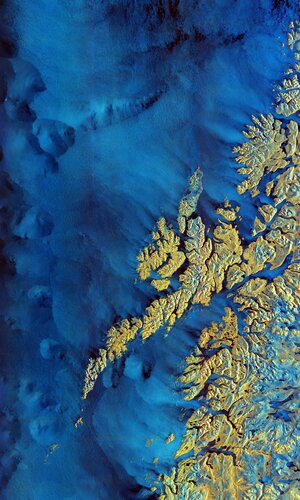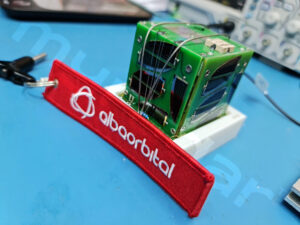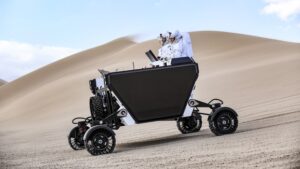Earth from Space: Lofoten, Norway
Friday, 11 March 2022 08:00
The Copernicus Sentinel-1 mission takes us over the archipelago of Lofoten in northern Norway.
NASA opens sample taken from the Moon 50 years on
Friday, 11 March 2022 07:26 The Apollo missions to the Moon brought a total of 2,196 rock samples to Earth. But NASA has only just started opening one of the last ones, collected 50 years ago.
For all that time, some tubes were kept sealed so that they could be studied years later, with the help of the latest technical breakthroughs.
NASA knew "science and technology would evolve and allow scientists to study the
The Apollo missions to the Moon brought a total of 2,196 rock samples to Earth. But NASA has only just started opening one of the last ones, collected 50 years ago.
For all that time, some tubes were kept sealed so that they could be studied years later, with the help of the latest technical breakthroughs.
NASA knew "science and technology would evolve and allow scientists to study the Giant impact crater in Greenland occurred a few million years after dinosaurs went extinct
Friday, 11 March 2022 07:26 Danish and Swedish researchers have dated the enormous Hiawatha impact crater, a 31 km-wide meteorite crater buried under a kilometer of Greenlandic ice. The dating ends speculation that the meteorite impacted after the appearance of humans and opens up a new understanding of Earth's evolution in the post-dinosaur era.
Ever since 2015, when researchers at the University of Copenhagen's GLO
Danish and Swedish researchers have dated the enormous Hiawatha impact crater, a 31 km-wide meteorite crater buried under a kilometer of Greenlandic ice. The dating ends speculation that the meteorite impacted after the appearance of humans and opens up a new understanding of Earth's evolution in the post-dinosaur era.
Ever since 2015, when researchers at the University of Copenhagen's GLO USSF, USC sign MOU establishing university partnership program
Friday, 11 March 2022 07:26 The U.S. Space Force (USSF) formally announced the University of Southern California (USC) as its newest University Partnership Program member at a Memorandum of Understanding (MOU) signing event Feb. 28 at USC. Lt. Gen. Michael A. Guetlein, commander of USSF's Space Systems Command, joined USC President Carol Folt at USC's University Park Campus for the signing.
Other Space Systems Comman
The U.S. Space Force (USSF) formally announced the University of Southern California (USC) as its newest University Partnership Program member at a Memorandum of Understanding (MOU) signing event Feb. 28 at USC. Lt. Gen. Michael A. Guetlein, commander of USSF's Space Systems Command, joined USC President Carol Folt at USC's University Park Campus for the signing.
Other Space Systems Comman Register for ESA’s Living Planet Symposium in Bonn
Friday, 11 March 2022 07:10
The time has come to register to attend the European Space Agency’s Living Planet Symposium – one of the largest Earth observation conferences in the world. Taking place on 23–27 May 2022 in Bonn, Germany, and jointly organised with the German Aerospace Center, this prestigious event allows all attendees to hear first-hand about the latest scientific findings on our planet. Attendees will also hear how observing Earth from space supports environmental research and action to combat the climate crisis, learn about novel Earth observing technologies and, importantly, learn about the new opportunities emerging in the rapidly changing sector
Acme plans 250-satellite weather data constellation
Friday, 11 March 2022 03:45
Acme AtronOmatic, vendor of the MyRadar weather app, won FCC approval to launch satellites to demonstrate technology for a constellation that ultimately could include 250 satellites or more.
The post Acme plans 250-satellite weather data constellation appeared first on SpaceNews.
Slingshot Aerospace raises $25M in Series A-1 Funding Round
Friday, 11 March 2022 01:16 Slingshot Aerospace, Inc., a company building world-class space simulation and analytics products to accelerate space sustainability, has announced that it has raised $25 million in Series A-1 funds. The new money is in addition to the $9.6 million Series A funds raised in October 2020, bringing the total raised for the A and A-1 rounds to $34.6 million to date.
The oversubscribed A-1 rou
Slingshot Aerospace, Inc., a company building world-class space simulation and analytics products to accelerate space sustainability, has announced that it has raised $25 million in Series A-1 funds. The new money is in addition to the $9.6 million Series A funds raised in October 2020, bringing the total raised for the A and A-1 rounds to $34.6 million to date.
The oversubscribed A-1 rou AST SpaceMobile announces launch deal with SpaceX
Friday, 11 March 2022 01:16 AST SpaceMobile, Inc. (NASDAQ: ASTS), the company building the first and only space-based cellular broadband network accessible directly by standard mobile phones, has announced it has signed a multi-launch agreement with Space Exploration Technologies Corp. ("SpaceX"). In addition to the planned summer launch of the BlueWalker 3 test satellite (BW3), the agreement covers the launch of the first
AST SpaceMobile, Inc. (NASDAQ: ASTS), the company building the first and only space-based cellular broadband network accessible directly by standard mobile phones, has announced it has signed a multi-launch agreement with Space Exploration Technologies Corp. ("SpaceX"). In addition to the planned summer launch of the BlueWalker 3 test satellite (BW3), the agreement covers the launch of the first Satellogic to launch five satellites on SpaceX Transporter-4 Mission
Friday, 11 March 2022 01:16 Satellogic Inc. (NASDAQ: SATL), a leader in sub-meter resolution satellite imagery collection, reports it has shipped five satellites to be launched in early Q2 from Cape Canaveral. The launch will be part of SpaceX's Transporter-4 mission onboard the highly flight-proven Falcon 9 reusable, two-stage rocket, under SpaceX's Rideshare program.
The upcoming launch includes the first deploymen
Satellogic Inc. (NASDAQ: SATL), a leader in sub-meter resolution satellite imagery collection, reports it has shipped five satellites to be launched in early Q2 from Cape Canaveral. The launch will be part of SpaceX's Transporter-4 mission onboard the highly flight-proven Falcon 9 reusable, two-stage rocket, under SpaceX's Rideshare program.
The upcoming launch includes the first deploymen Sidus Space completes LizzieSat Preliminary Design Review
Friday, 11 March 2022 01:16 Sidus Space, Inc. (NASDAQ:SIDU), a Space-as-a-Service satellite company focused on commercial satellite design, manufacture, launch, and data collection is pleased to announce the successful completion of the LizzieSat (LS) Preliminary Design Review (PDR).
A PDR ensures the design and basic system architecture are complete and that there is technical confidence the capability need can be s
Sidus Space, Inc. (NASDAQ:SIDU), a Space-as-a-Service satellite company focused on commercial satellite design, manufacture, launch, and data collection is pleased to announce the successful completion of the LizzieSat (LS) Preliminary Design Review (PDR).
A PDR ensures the design and basic system architecture are complete and that there is technical confidence the capability need can be s Esri releases updated land-cover map with new sets of global data
Friday, 11 March 2022 01:16 Governments and businesses across the world are pledging to adopt more sustainable and equitable practices. Many are also working to limit activities that contribute to climate change. To support these efforts, Esri, the global leader in location intelligence, in partnership with Impact Observatory and Microsoft, is releasing a globally consistent 2017-2021 global land-use and land-cover map of
Governments and businesses across the world are pledging to adopt more sustainable and equitable practices. Many are also working to limit activities that contribute to climate change. To support these efforts, Esri, the global leader in location intelligence, in partnership with Impact Observatory and Microsoft, is releasing a globally consistent 2017-2021 global land-use and land-cover map of Sol 3411: Bonanza
Friday, 11 March 2022 01:16 After significant churn in Monday's planning, today turned out to be a single sol's worth of untargeted science. That left GEO with only a ChemCam AEGIS activity, where ChemCam automatically identifies and targets an interesting rock near the rover by itself. ENV than planned a bonanza of atmospheric monitoring activities, as we had power to spare.
This included 7 dust devil movies with 4
After significant churn in Monday's planning, today turned out to be a single sol's worth of untargeted science. That left GEO with only a ChemCam AEGIS activity, where ChemCam automatically identifies and targets an interesting rock near the rover by itself. ENV than planned a bonanza of atmospheric monitoring activities, as we had power to spare.
This included 7 dust devil movies with 4 The start of the birth of planets in a binary star system observed
Friday, 11 March 2022 01:16 Astronomers have observed primordial material that may be giving birth to three planetary systems around a binary star in unprecedented detail.
Bringing together three decades of study, an international group of scientists have observed a pair of stars orbiting each other, to reveal that these stars are surrounded by disks of gas and dust. Research published in The Astrophysical Journal, s
Astronomers have observed primordial material that may be giving birth to three planetary systems around a binary star in unprecedented detail.
Bringing together three decades of study, an international group of scientists have observed a pair of stars orbiting each other, to reveal that these stars are surrounded by disks of gas and dust. Research published in The Astrophysical Journal, s Cosmic particle accelerator at its limit
Friday, 11 March 2022 01:16 With the help of special telescopes, researchers have observed a cosmic particle accelerator as never before. Observations made with the gamma ray observatory H.E.S.S. in Namibia show for the first time the course of an acceleration process in a stellar process called a nova, which comprises powerful eruptions on the surface of a white dwarf.
A nova creates a shock wave that tears through
With the help of special telescopes, researchers have observed a cosmic particle accelerator as never before. Observations made with the gamma ray observatory H.E.S.S. in Namibia show for the first time the course of an acceleration process in a stellar process called a nova, which comprises powerful eruptions on the surface of a white dwarf.
A nova creates a shock wave that tears through Astrolab unveils Artemis lunar rover design
Thursday, 10 March 2022 22:36
A California startup has developed and tested a prototype of a lunar rover that it plans to offer to NASA for use on future Artemis missions.
The post Astrolab unveils Artemis lunar rover design appeared first on SpaceNews.

